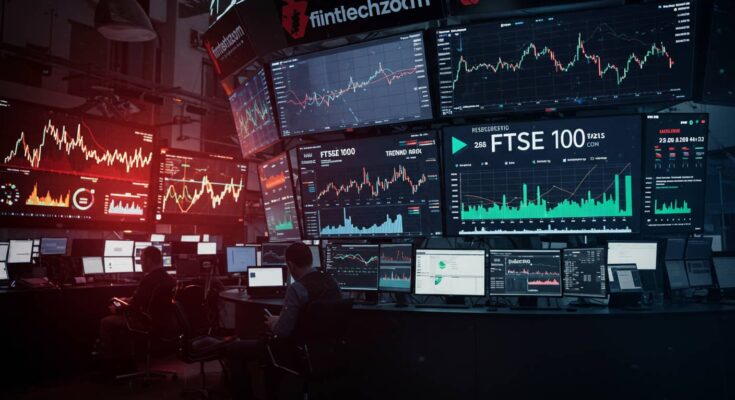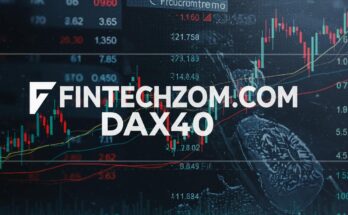Introduction
The primary benchmark for British stocks is the FTSE 100, also known as the “Footsie,” which tracks the top 100 businesses by market capitalization listed on the London Stock Exchange. Understanding the dynamics of this index is crucial for seasoned portfolio managers and retail investors alike to gauge the health of the UK economy and global market sentiment. By leveraging the depth of data and analysis provided by fintechzoom.com ftse 100, users gain real‑time insights, historical context, and actionable strategies to make more informed investment decisions.
Whether your goal is dividend income, long‑term capital growth, or tactical sector rotation, this guide will walk you through everything—from the basics and history of the FTSE 100 to advanced technical tools, sector breakdowns, comparative analysis, and frequently asked questions. Let’s embark on this adventure to become experts in one of the most significant indices in the world.
Understanding the FTSE 100: An Overview
What Is the FTSE 100 Index?
The FTSE 100, a market capitalization-weighted index, represents the performance of the 100 biggest UK-listed firms. These blue‑chip names span diverse industries—from energy giants to financial institutions—offering a comprehensive barometer of corporate Britain. Tracking daily movements in the FTSE 100 helps investors assess overall market momentum and gauge shifts in investor confidence.
History and Evolution
Since its inception on January 3, 1984, with a base value of 1,000 points, the FTSE 100 has become a globally recognized benchmark. It was created to replace the old FT30 and has been maintained by the FTSE Group—part of the London Stock Exchange—ever since. Over the decades, it has weathered economic cycles, geopolitical events, and regulatory changes yet continues to adapt through quarterly reviews that add or remove constituents based on market cap.
How FintechZoom.com FTSE 100 Enhances Market Understanding
Key Features Offered
At fintechzoom.com ftse 100, you’ll live index tracking updates every few seconds during trading hours, along with in-depth company profiles featuring earnings data, dividend histories, and valuation metrics. Interactive charts allow you to overlay technical indicators, compare performance across sectors, and even back‑test simple strategies. All of these tools converge to transform raw data into clear, actionable intelligence.
User‑Centric Interface
The platform is built for ease of use, whether on a desktop at your office or checking markets on your phone during your commute. Customizable dashboards let you pin your favorite stocks, sectors, or indices while setting price alert notifications to catch critical moves. Thanks to well-designed menus and simple navigation, you may spend more time analyzing information and searching for it less.
Why the FTSE 100 Is a Cornerstone Index
Economic Representation
Given that many FTSE 100 constituents earn a significant share of revenue overseas, this index reflects domestic UK conditions and global demand trends. The FTSE 100’s multinational nature provides built‑in diversification and resilience against purely local economic shocks, from oil prices impacting energy majors to currency fluctuations affecting export-driven firms.
Investor Confidence
The index is home to stalwarts with decades of dividend‑paying track records, which attracts income‑seeking investors, particularly in low‑interest‑rate environments. In times of market stress, the FTSE 100 often outperforms more volatile benchmarks, making it a go‑to option for those seeking a relatively stable equity exposure within their broader portfolios.
Top Companies in the FTSE 100 Index (as of 2025)
| Rank | Company | Sector | Market Cap (GBP) |
| 1 | Shell | Energy | £160B |
| 2 | HSBC Holdings | Finance | £130B |
| 3 | Unilever | Consumer Goods | £115B |
| 4 | AstraZeneca | Healthcare | £112B |
| 5 | BP | Energy | £105B |
These five blue‑chip names together represent a substantial portion of the FTSE 100’s total market capitalization—and they’re updated continuously on fintechzoom.com ftse 100, ensuring you always have the latest figures at your fingertips.
FTSE 100 vs Other Global Indices
FTSE 100 vs S&P 500
While the FTSE 100 carries heavyweight energy and financial stocks, the S&P 500 skews heavily toward technology and consumer discretionary names. The UK index typically offers higher dividend yields, whereas its US counterpart has delivered stronger growth driven by tech innovations. Investors must weigh income stability against growth potential when allocating across these benchmarks.
FTSE 100 vs FTSE 250
The FTSE 250 is often seen as the “mid‑cap” companion to the FTSE 100, focusing on the following 250 largest UK companies. Because many of these firms are more domestically oriented, the FTSE 250 tends to be more sensitive to UK economic data. Meanwhile, the FTSE 100, with its global footprint, provides comparatively steadier returns and broader international exposure.
Sectoral Influence on the FTSE 100
Dominant Sectors
Four sectors—energy, financials, healthcare, and consumer goods—constitute over half of the FTSE 100’s weight. Movements in oil and gas prices directly impact the energy giants, while interest‑rate shifts influence banking and insurance firms. Healthcare and consumer goods offer defensive ballast, often shielding the index during turbulent markets.
FintechZoom’s Sector Performance Heatmaps
On fintechzoom.com ftse 100, you can view color‑coded heatmaps that instantly reveal which sectors outperform or lag on a given day. These visual tools help you spot trends at a glance, such as a rotation from financials into consumer staples or a surge in healthcare stocks following a biotech breakthrough.
Technical Analysis Made Easy
Tools for Intermediate to Advanced Users
Fintechzoom.com ftse 100 offers indicators such as moving averages, Bollinger Bands, RSI, and MACD for chart-savvy investors. You can draw trendlines, identify support and resistance levels, and even script simple back‑tests to validate your strategies against historical data.
Tools for Beginners
If you’re new to technical analysis, the platform offers pre‑configured chart templates alongside plain English educational guides. Simple toggles let you add fundamental indicators and view concise explanations of what they measure—no prior experience is required.
Economic Events That Impact FTSE 100 Performance
Macro Events to Watch
The FTSE 100 is influenced by Bank of England decisions, UK GDP releases, inflation reports, and geopolitical developments such as Brexit‑related negotiations. With its economic calendar that includes pre- and post-event research, fintechzoom.com FTSE 100 assists you in anticipating volatility and allocating your portfolio appropriately.
Dividend Investing Through the FTSE 100
Why the FTSE 100 Appeals to Income Investors
Many constituents boast decades of uninterrupted dividend payments, supported by strong free cash flow. In a global landscape of low‑yield bonds, the FTSE 100’s dividend yields—often in the 3–5% range—provide a compelling source of passive income for retirees and yield‑focused strategies.
FintechZoom Dividend Calendar
The dividend calendar on fintechzoom.com ftse 100 displays ex‑dividend dates, payment amounts, and historical yield data, allowing you to systematically plan cash flows and reinvest dividends. This clarity transforms dividend investing from guesswork into a precise, income‑driving discipline.
Building a Balanced FTSE 100 Portfolio
Diversification Tips
Even within the FTSE 100, over‑concentration in a single sector can amplify risk. Consider blending defensive sectors (consumer staples, healthcare) with cyclical areas (energy, industrials) to smooth returns across market cycles. fintechzoom.com ftse 100 filters help you pinpoint companies by sector weight, beta, and dividend yield to optimize balance.
Rebalancing Strategies
Market trends evolve, so revisit your allocations every quarter or semi‑annually. Use portfolio‑tracking tools on fintechzoom.com ftse 100 to compare current weightings against targets, then rebalance by trimming outperformers and adding to laggards, keeping risk in check.
Comparative Analysis Tools
Beyond raw numbers, fintechzoom.com ftse 100 lets you overlay the FTSE 100 against other indices—such as the S&P 500, Euro Stoxx 50, or FTSE 100 Futures. You can see relative performance charts, calculate correlation coefficients, and even run scatter‑plot analyses, deepening your understanding of global market relationships.
Future Outlook: AI & ESG on FintechZoom
Predictive Analytics
FintechZoom’s roadmap includes AI‑driven earnings forecasts and volatility models that flag potential stock moves before they happen. These machine‑learning tools augment traditional analysis, giving you a predictive edge in fast‑moving markets.
ESG and Sustainability Tracking
With ESG (Environmental, Social, Governance) criteria gaining traction, FintechZoom plans to introduce ESG scores and sustainability ratings for FTSE 100 companies. This will empower investors to align portfolios with ethical standards without sacrificing returns.
FAQs: People Also Ask
What is fintechzoom.com ftse 100?
It’s the dedicated FTSE 100 section on FintechZoom.com, offering live price feeds, charts, news, and analysis for the UK’s top 100 companies.
How accurate is the data on fintechzoom.com ftse 100?
Data is refreshed in real-time from primary exchange feeds and audited each trading day, ensuring professional‑grade accuracy.
Can beginners use fintechzoom.com ftse 100?
Absolutely. The site provides beginner tutorials, simplified charts, and glossary terms to help new investors learn quickly.
Does fintechzoom.com ftse 100 require a subscription?
Basic features are free, while advanced tools—like custom back‑tests and AI forecasts—are part of the premium package.
How can I track dividends with fintechzoom.com ftse 100?
Use the dividend calendar to view upcoming ex‑dividend dates, yields, and historical payout trends all in one place.
Conclusion
Navigating the FTSE 100 need not be daunting. By harnessing the robust data feeds, interactive charts, and expert commentary of fintechzoom.com ftse 100, investors at every level can demystify market movements, craft balanced portfolios, and seize opportunities as they arise. From reliable dividend income to tactical sector plays and advanced AI forecasting on the horizon, the platform equips you with everything needed to stay ahead in the ever‑evolving landscape of UK equities.



